belt MAZDA MODEL MX-5 MIATA PRHT 2013 Owner's Manual
[x] Cancel search | Manufacturer: MAZDA, Model Year: 2013, Model line: MODEL MX-5 MIATA PRHT, Model: MAZDA MODEL MX-5 MIATA PRHT 2013Pages: 452, PDF Size: 5.57 MB
Page 34 of 452
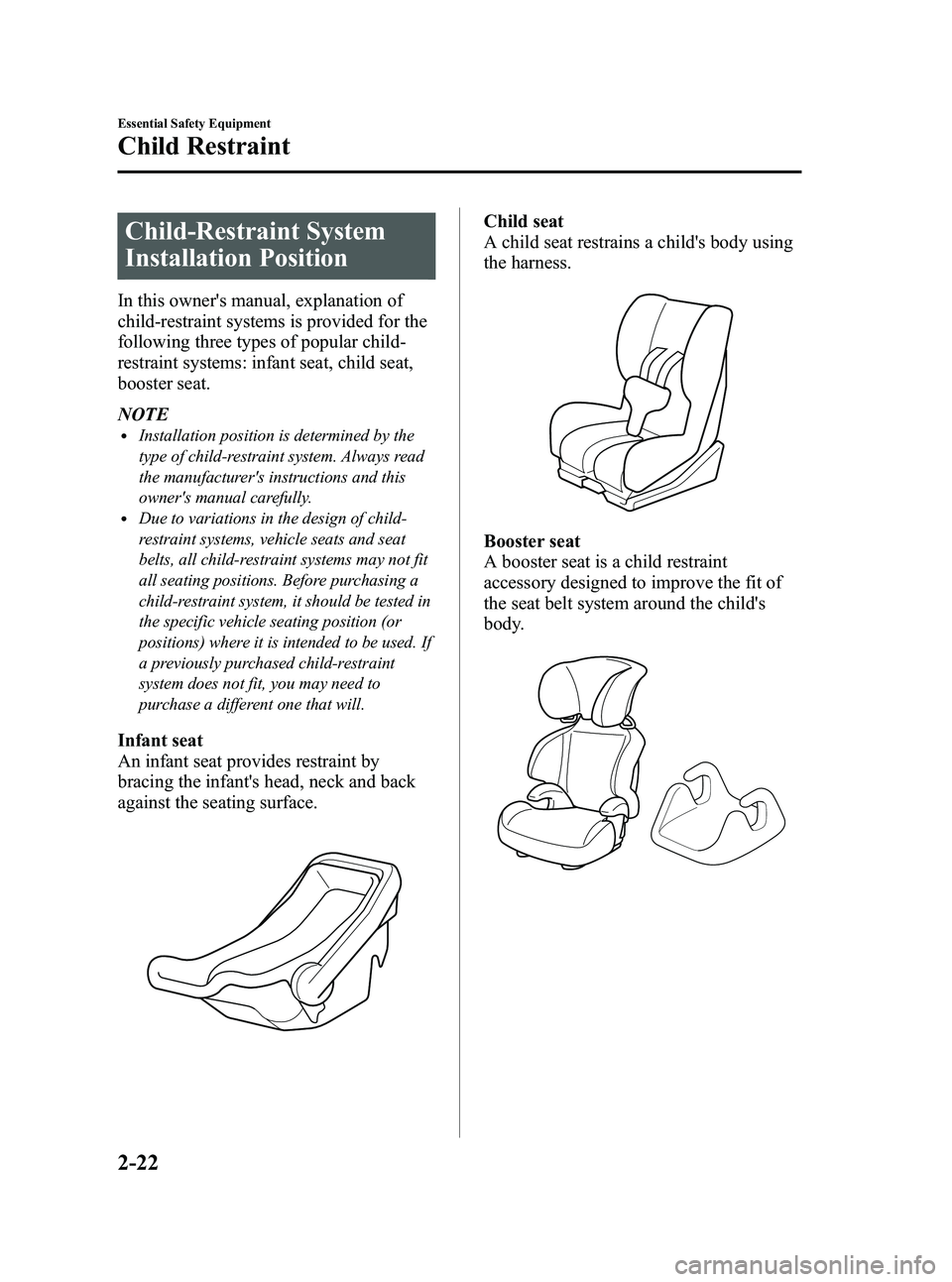
Black plate (34,1)
Child-Restraint System
Installation Position
In this owner's manual, explanation of
child-restraint systems is provided for the
following three types of popular child-
restraint systems: infant seat, child seat,
booster seat.
NOTE
lInstallation position is determined by the
type of child-restraint system. Always read
the manufacturer's instructions and this
owner's manual carefully.
lDue to variations in the design of child-
restraint systems, vehicle seats and seat
belts, all child-restraint systems may not fit
all seating positions. Before purchasing a
child-restraint system, it should be tested in
the specific vehicle seating position (or
positions) where it is intended to be used. If
a previously purchased child-restraint
system does not fit, you may need to
purchase a different one that will.
Infant seat
An infant seat provides restraint by
bracing the infant's head, neck and back
against the seating surface.
Child seat
A child seat restrains a child's body using
the harness.
Booster seat
A booster seat is a child restraint
accessory designed to improve the fit of
the seat belt system around the child's
body.
2-22
Essential Safety Equipment
Child Restraint
MX-5_8CM3-EA-12F_Edition2 Page34
Friday, August 31 2012 1:44 PM
Form No.8CM3-EA-12F
Page 35 of 452
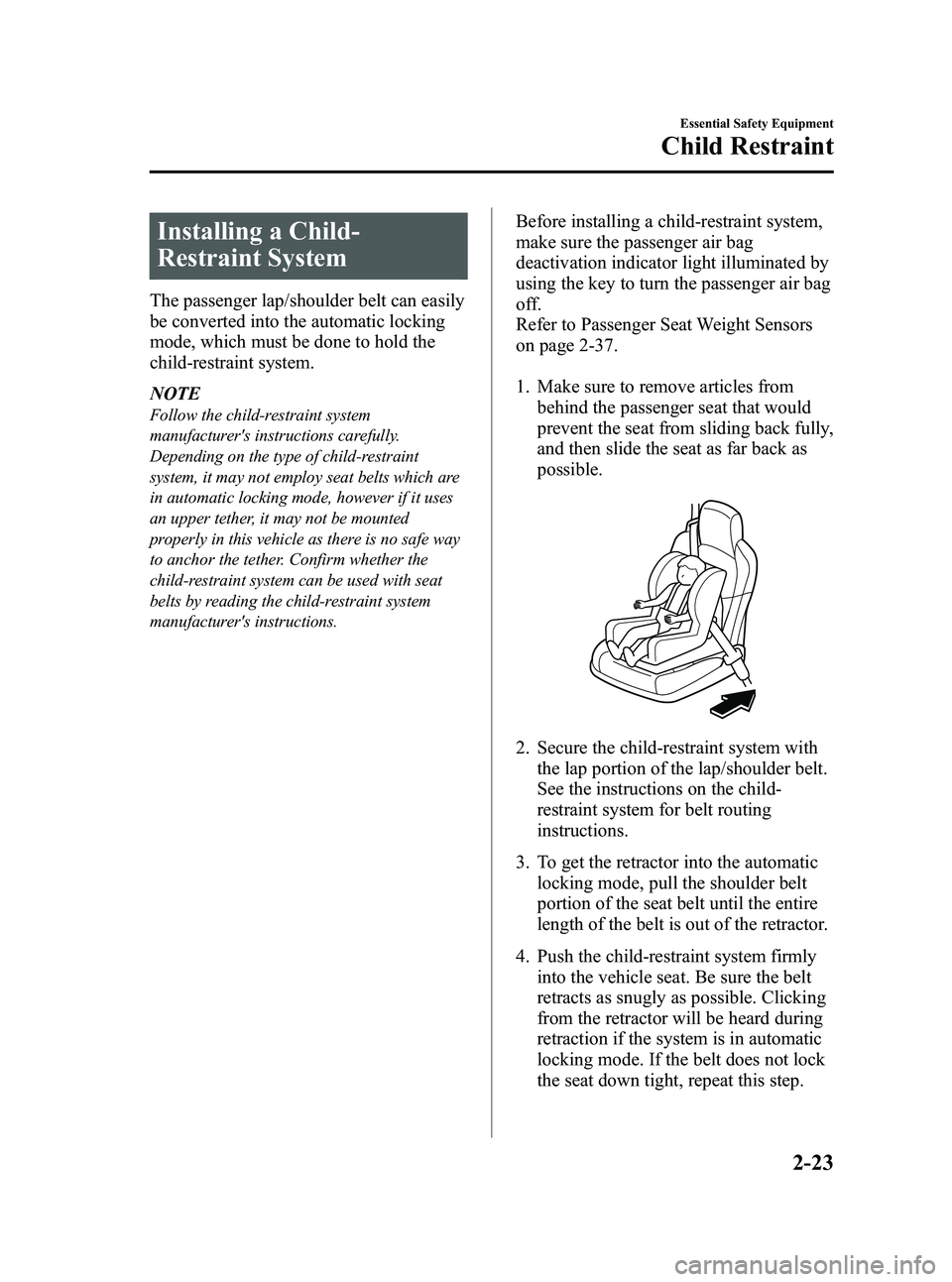
Black plate (35,1)
Installing a Child-
Restraint System
The passenger lap/shoulder belt can easily
be converted into the automatic locking
mode, which must be done to hold the
child-restraint system.
NOTE
Follow the child-restraint system
manufacturer's instructions carefully.
Depending on the type of child-restraint
system, it may not employ seat belts which are
in automatic locking mode, however if it uses
an upper tether, it may not be mounted
properly in this vehicle as there is no safe way
to anchor the tether. Confirm whether the
child-restraint system can be used with seat
belts by reading the child-restraint system
manufacturer's instructions.
Before installing a child-restraint system,
make sure the passenger air bag
deactivation indicator light illuminated by
using the key to turn the passenger air bag
off.
Refer to Passenger Seat Weight Sensors
on page 2-37.
1. Make sure to remove articles frombehind the passenger seat that would
prevent the seat from sliding back fully,
and then slide the seat as far back as
possible.
2. Secure the child-restraint system withthe lap portion of the lap/shoulder belt.
See the instructions on the child-
restraint system for belt routing
instructions.
3. To get the retractor into the automatic locking mode, pull the shoulder belt
portion of the seat belt until the entire
length of the belt is out of the retractor.
4. Push the child-restraint system firmly into the vehicle seat. Be sure the belt
retracts as snugly as possible. Clicking
from the retractor will be heard during
retraction if the system is in automatic
locking mode. If the belt does not lock
the seat down tight, repeat this step.
Essential Safety Equipment
Child Restraint
2-23
MX-5_8CM3-EA-12F_Edition2 Page35
Friday, August 31 2012 1:44 PM
Form No.8CM3-EA-12F
Page 36 of 452
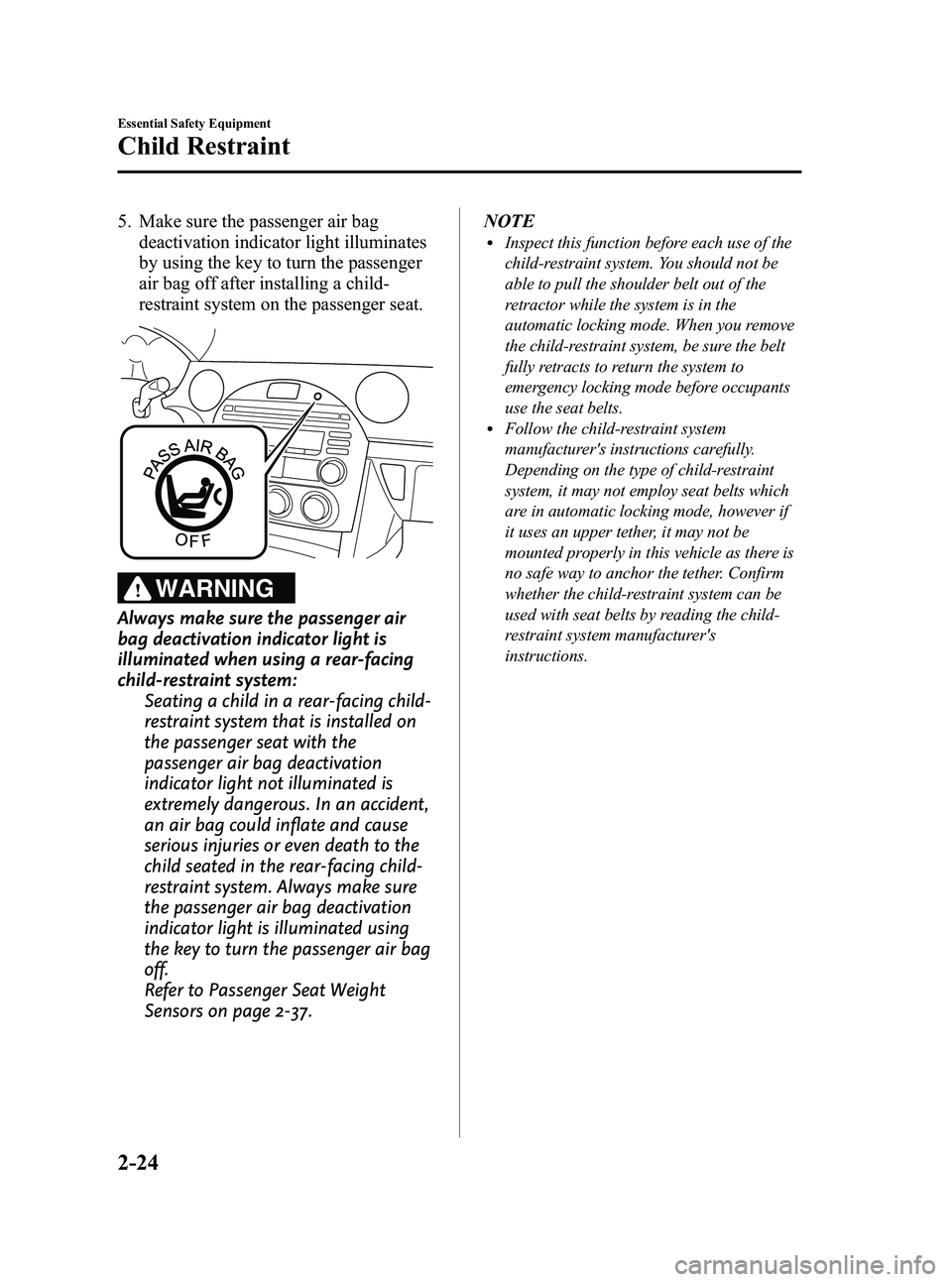
Black plate (36,1)
5. Make sure the passenger air bagdeactivation indicator light illuminates
by using the key to turn the passenger
air bag off after installing a child-
restraint system on the passenger seat.
WARNING
Always make sure the passenger air
bag deactivation indicator light is
illuminated when using a rear-facing
child-restraint system: Seating a child in a rear-facing child-
restraint system that is installed on
the passenger seat with the
passenger air bag deactivation
indicator light not illuminated is
extremely dangerous. In an accident,
an air bag could inflate and cause
serious injuries or even death to the
child seated in the rear-facing child-
restraint system. Always make sure
the passenger air bag deactivation
indicator light is illuminated using
the key to turn the passenger air bag
off.
Refer to Passenger Seat Weight
Sensors on page 2-37. NOTE
lInspect this function before each use of the
child-restraint system. You should not be
able to pull the shoulder belt out of the
retractor while the system is in the
automatic locking mode. When you remove
the child-restraint system, be sure the belt
fully retracts to return the system to
emergency locking mode before occupants
use the seat belts.
lFollow the child-restraint system
manufacturer's instructions carefully.
Depending on the type of child-restraint
system, it may not employ seat belts which
are in automatic locking mode, however if
it uses an upper tether, it may not be
mounted properly in this vehicle as there is
no safe way to anchor the tether. Confirm
whether the child-restraint system can be
used with seat belts by reading the child-
restraint system manufacturer's
instructions.
2-24
Essential Safety Equipment
Child Restraint
MX-5_8CM3-EA-12F_Edition2 Page36
Friday, August 31 2012 1:44 PM
Form No.8CM3-EA-12F
Page 37 of 452

Black plate (37,1)
Supplemental Restraint System (SRS) Precautions
The front and side supplemental restraint systems (SRS) include up to 4 air bags.Please
verify the air bags equipped on your vehicle by locating the “SRS AIRBAG ”location
indicators. These indicators are visible in the area where the air bags are installed.
The air bags are installed in the following locations:
lThe steering wheel hub (driver air bag)lThe passenger dashboard (passenger air bag)lThe outboard sides of the seatbacks (side air bags)í
The air bag supplemental restraint systems are designed to provide supplemental protection
in certain situations, so seat belts are always important in the following ways:
Without seat belt usage, the air bags cannot provide adequate protection during an accident.
Seat belt usage is necessary to:
lKeep the occupant from being thrown into an inflating air bag.lReduce the possibility of injuries during an accident that is not designed for air bag
inflation, such as roll-over or rear impact.
lReduce the possibility of injuries in frontal, near frontal, side collisions that are not
severe enough to activate the air bags.
lReduce the possibility of being thrown from your vehicle.lReduce the possibility of injuries to lower body and legs during an accident because the
air bags provide no protection to these parts of the body.
lHold the driver in a position which allows better control of the vehicle.
If your vehicle is also equipped with a driver and passenger occupant classification
system, refer to the Driver and Passenger Occupant Classification System (page 2-37)
for details.
If your vehicle is equipped with a driver and passenger occupant classification system, the
passenger air bag deactivation indicator light illuminates for a specified time after the
ignition is switched ON.
Essential Safety Equipment
SRS Air Bags
2-25íSome models.
MX-5_8CM3-EA-12F_Edition2 Page37
Friday, August 31 2012 1:44 PM
Form No.8CM3-EA-12F
Page 38 of 452

Black plate (38,1)
Small children must be protected by a child-restraint system as stipulated by law in every
state and province. In certain states and provinces, larger children must use a child-restraint
system (page 2-18).
Carefully consider which child-restraint system is necessary for your child and follow the
installation directions in this Owner's Manual as well as the child-restraint system
manufacturer's instructions.
Do not use a child-restraint system which employs an upper tether because there is no
appropriate means to anchor the tether.
WARNING
Seat belts must be worn in air bag equipped vehicles:Depending only on the air bags for protection during an accident is dangerous.
Alone, air bags may not prevent serious injuries. The appropriate air bags can be
expected to inflate only in the first accident, such as frontal, near frontal, side
collisions that are at least moderate. Vehicle occupants should always wear seat
belts.
Never use a rear-facing child-restraint system in the front seat with an air bag that
could deploy: Rear-facing child-restraint systems on the front seat are particularly dangerous even
though you may feel assured that a front passenger air bag will not deploy based on
the fact that the front passenger air bag deactivation indicator light illuminates. The
child-restraint system can be hit by a deploying air bag and moved violently
backward resulting in serious injury or death to the child.
Do not sit too close to the driver and passenger air bags:Sitting too close to the driver and passenger air bag modules or placing hands or
feet on them is extremely dangerous. The driver and passenger air bags inflate with
great force and speed. Serious injuries could occur if someone is too close. The driver
should always hold onto only the rim of the steering wheel. The seat passenger
should keep both feet on the floor. Seat occupants should adjust their seats as far
back as possible and always sit upright against the seatbacks with seat belts worn
properly.
2-26
Essential Safety Equipment
SRS Air Bags
MX-5_8CM3-EA-12F_Edition2 Page38
Friday, August 31 2012 1:44 PM
Form No.8CM3-EA-12F
Page 39 of 452
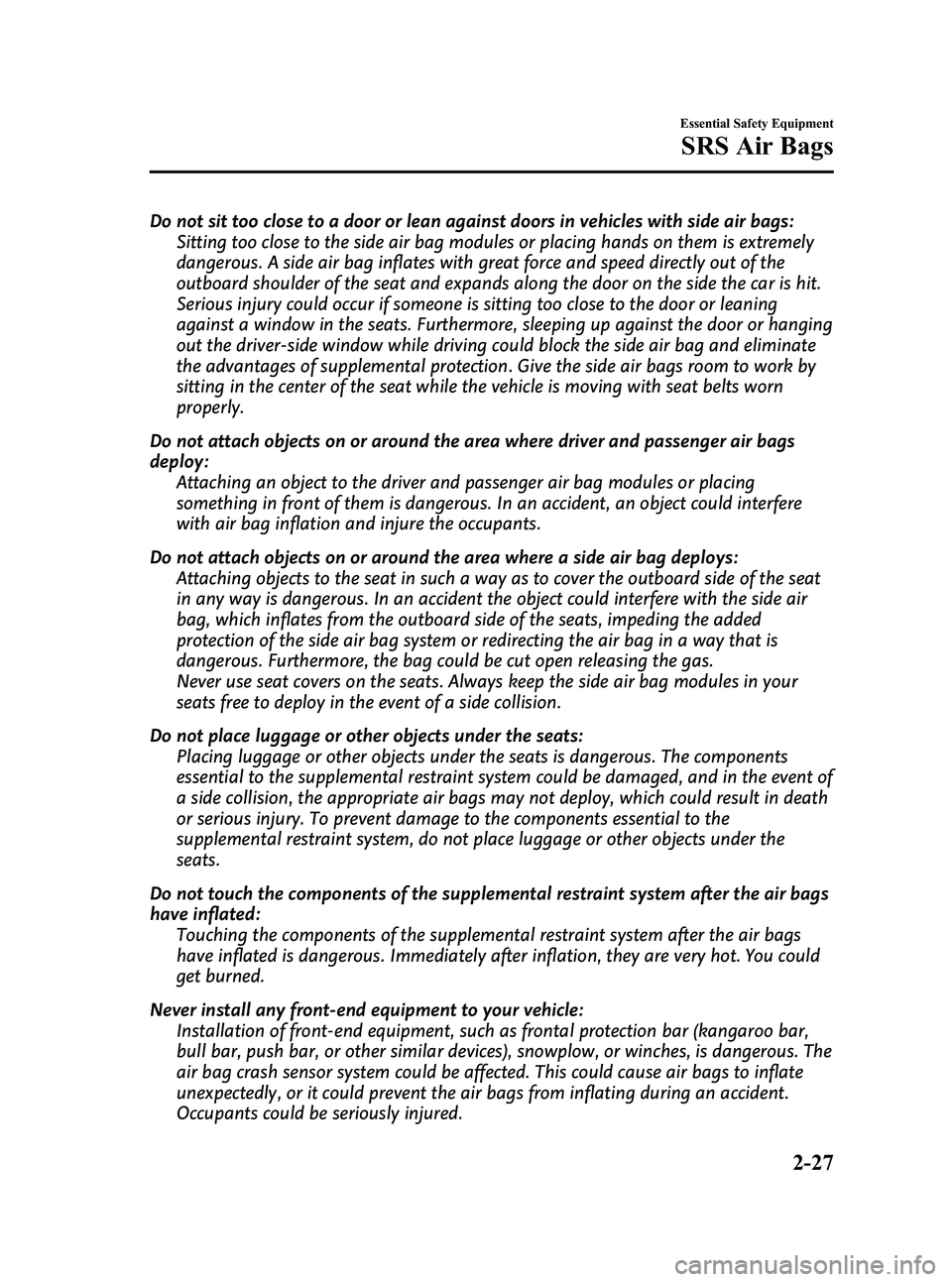
Black plate (39,1)
Do not sit too close to a door or lean against doors in vehicles with side air bags:Sitting too close to the side air bag modules or placing hands on them is extremely
dangerous. A side air bag inflates with great force and speed directly out of the
outboard shoulder of the seat and expands along the door on the side the car is hit.
Serious injury could occur if someone is sitting too close to the door or leaning
against a window in the seats. Furthermore, sleeping up against the door or hanging
out the driver-side window while driving could block the side air bag and eliminate
the advantages of supplemental protection. Give the side air bags room to work by
sitting in the center of the seat while the vehicle is moving with seat belts worn
properly.
Do not attach objects on or around the area where driver and passenger air bags
deploy: Attaching an object to the driver and passenger air bag modules or placing
something in front of them is dangerous. In an accident, an object could interfere
with air bag inflation and injure the occupants.
Do not attach objects on or around the area where a side air bag deploys: Attaching objects to the seat in such a way as to cover the outboard side of the seat
in any way is dangerous. In an accident the object could interfere with the side air
bag, which inflates from the outboard side of the seats, impeding the added
protection of the side air bag system or redirecting the air bag in a way that is
dangerous. Furthermore, the bag could be cut open releasing the gas.
Never use seat covers on the seats. Always keep the side air bag modules in your
seats free to deploy in the event of a side collision.
Do not place luggage or other objects under the seats: Placing luggage or other objects under the seats is dangerous. The components
essential to the supplemental restraint system could be damaged, and in the event of
a side collision, the appropriate air bags may not deploy, which could result in death
or serious injury. To prevent damage to the components essential to the
supplemental restraint system, do not place luggage or other objects under the
seats.
Do not touch the components of the supplemental restraint system after the air bags
have inflated: Touching the components of the supplemental restraint system after the air bags
have inflated is dangerous. Immediately after inflation, they are very hot. You could
get burned.
Never install any front-end equipment to your vehicle: Installation of front-end equipment, such as frontal protection bar (kangaroo bar,
bull bar, push bar, or other similar devices), snowplow, or winches, is dangerous. The
air bag crash sensor system could be affected. This could cause air bags to inflate
unexpectedly, or it could prevent the air bags from inflating during an accident.
Occupants could be seriously injured.
Essential Safety Equipment
SRS Air Bags
2-27
MX-5_8CM3-EA-12F_Edition2 Page39
Friday, August 31 2012 1:44 PM
Form No.8CM3-EA-12F
Page 41 of 452

Black plate (41,1)
Supplemental Restraint System Components
Driver/Passenger inflators and air bags
Crash sensor, and diagnostic module (SAS unit)
Seat belt pretensioner and load limiting systems (page 2-13)
Front air bag sensor
Side crash sensorsí
Air bag/seat belt pretensioner system warning light (page 2-32)
Side inflators and air bagsí
Passenger air bag deactivation indicator light (page 2-37)
Passenger seat weight sensors (page 2-37)
Passenger seat weight sensor control module
Driver and passenger seat belt buckle switches (page 2-40)
Driver seat slide position sensor (page 2-37)
Essential Safety Equipment
SRS Air Bags
2-29íSome models.
MX-5_8CM3-EA-12F_Edition2 Page41
Friday, August 31 2012 1:44 PM
Form No.8CM3-EA-12F
Page 42 of 452
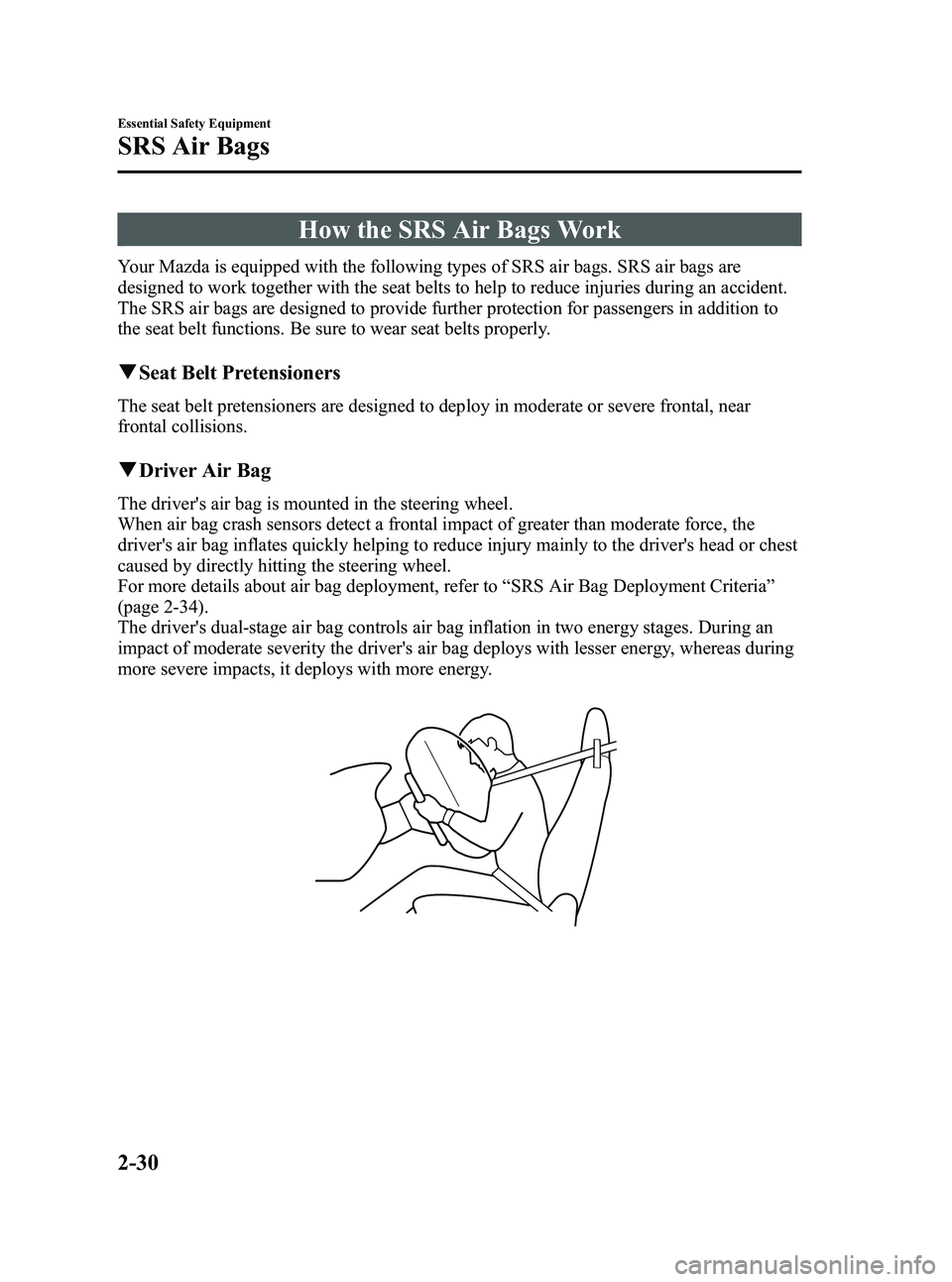
Black plate (42,1)
How the SRS Air Bags Work
Your Mazda is equipped with the following types of SRS air bags. SRS air bags are
designed to work together with the seat belts to help to reduce injuries during an accident.
The SRS air bags are designed to provide further protection for passengers in addition to
the seat belt functions. Be sure to wear seat belts properly.
qSeat Belt Pretensioners
The seat belt pretensioners are designed to deploy in moderate or severe frontal, near
frontal collisions.
qDriver Air Bag
The driver's air bag is mounted in the steering wheel.
When air bag crash sensors detect a frontal impact of greater than moderate force, the
driver's air bag inflates quickly helping to reduce injury mainly to the driver's head or chest
caused by directly hitting the steering wheel.
For more details about air bag deployment, refer to “SRS Air Bag Deployment Criteria ”
(page 2-34).
The driver's dual-stage air bag controls air bag inflation in two energy stages. During an
impact of moderate severity the driver's air bag deploys with lesser energy, whereas during
more severe impacts, it deploys with more energy.
2-30
Essential Safety Equipment
SRS Air Bags
MX-5_8CM3-EA-12F_Edition2 Page42
Friday, August 31 2012 1:44 PM
Form No.8CM3-EA-12F
Page 44 of 452
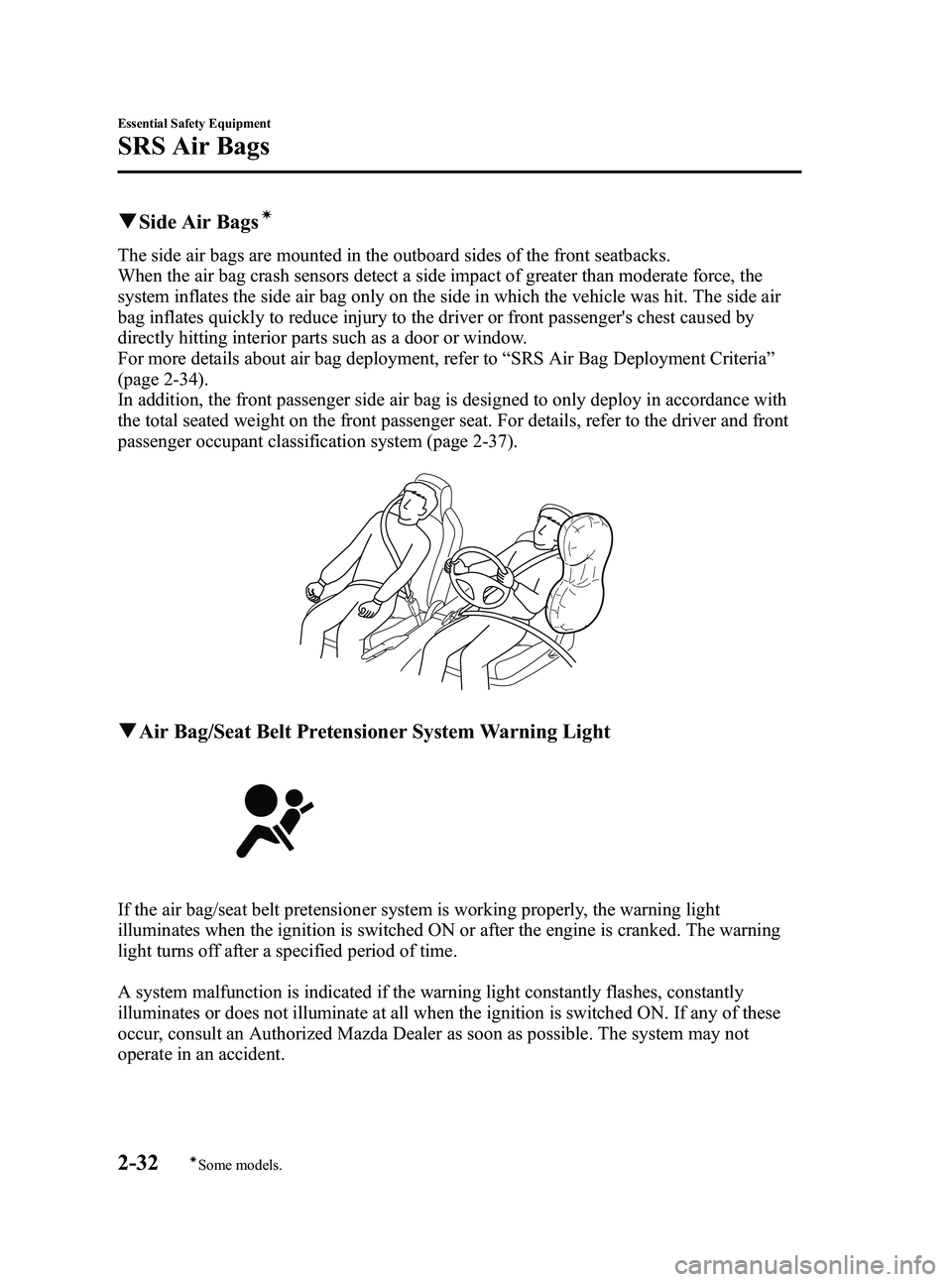
Black plate (44,1)
qSide Air Bagsí
The side air bags are mounted in the outboard sides of the front seatbacks.
When the air bag crash sensors detect a side impact of greater than moderate force, the
system inflates the side air bag only on the side in which the vehicle was hit. The side air
bag inflates quickly to reduce injury to the driver or front passenger's chest caused by
directly hitting interior parts such as a door or window.
For more details about air bag deployment, refer to “SRS Air Bag Deployment Criteria ”
(page 2-34).
In addition, the front passenger side air bag is designed to only deploy in accordance with
the total seated weight on the front passenger seat. For details, refer to the driver and front
passenger occupant classification system (page 2-37).
q Air Bag/Seat Belt Pretensioner System Warning Light
If the air bag/seat belt pretensioner system is working properly, the warning light
illuminates when the ignition is switched ON or after the engine is cranked. The warning
light turns off after a specified period of time.
A system malfunction is indicated if the warning light constantly flashes, constantly
illuminates or does not illuminate at all when the ignition is switched ON. If any of these
occur, consult an Authorized Mazda Dealer as soon as possible. The system may not
operate in an accident.
2-32
Essential Safety Equipment
íSome models.
SRS Air Bags
MX-5_8CM3-EA-12F_Edition2 Page44
Friday, August 31 2012 1:44 PM
Form No.8CM3-EA-12F
Page 46 of 452

Black plate (46,1)
SRS Air Bag Deployment Criteria
This chart indicates the applicable SRS equipment that will deploy depending on the type
of collision.
(The illustrations are the representative cases of collisions.)
SRS
equipment Types of collision
A severe frontal/near frontal collision A severe side collision A rear collision
Seat belt
pretensioner X*1(both sides)
No air bag and front seat
belt pretensioner will be
activated in a rear collision.
Driver air
bag X
Passenger air bag X
*1
Side air
bagíX*1(impact side only)
X: The SRS air bag equipment is designed to deploy in a collision.
*1: The passenger front and side air bags and the seat belt pretensioner are designed to deploy depending on the condition of the total seated weight on the passenger seat.
2-34
Essential Safety Equipment
íSome models.
SRS Air Bags
MX-5_8CM3-EA-12F_Edition2 Page46
Friday, August 31 2012 1:44 PM
Form No.8CM3-EA-12F